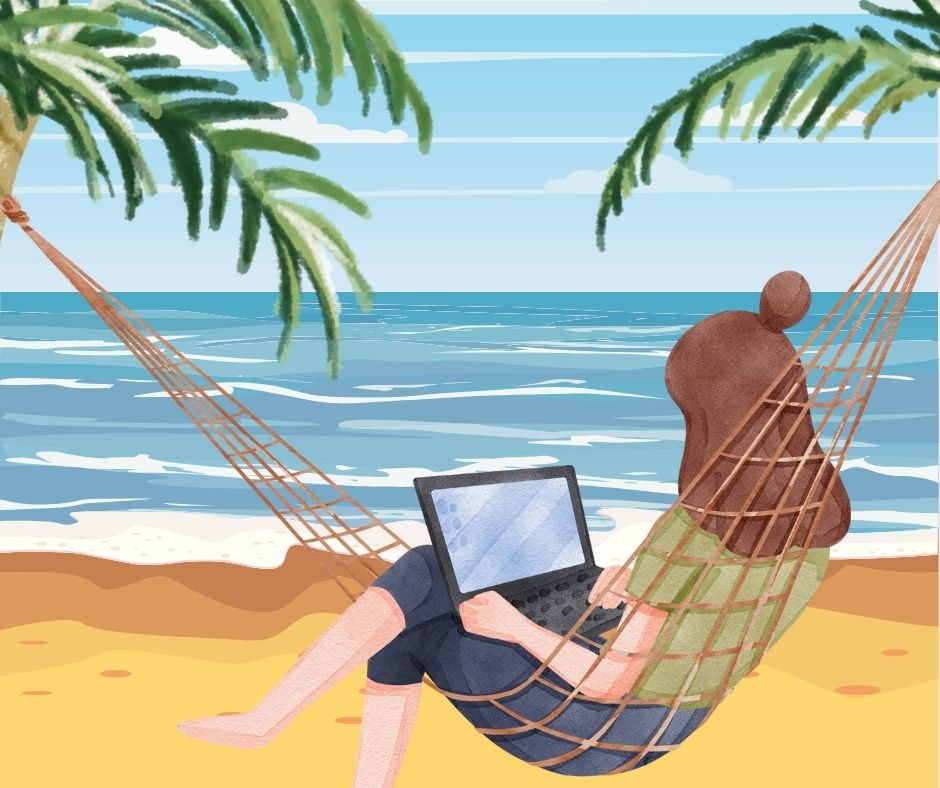Beyond the Desk: Best Writing Locations to Inspire Romance Authors

Table of Contents
I recently watched an interview of Amy Daws on Passionflix where she showed off the writing area her local tire shop set up for her to work. I’ve written in many locations, but I’ve never written at a tire shop. If my car has to go in, I usually walk to a cafe or arrange a ride to Starbucks or the bookstore.
But even if your car doesn’t need work, writing in the same spot, day after day, can get old. As a romance author, your creativity thrives on atmosphere, emotion, and inspiration. If you’ve ever found yourself struggling to write or feeling uninspired, a simple change of scenery might be exactly what you need.
The good news? You don’t have to go to your local tire shop or travel far to find inspiration. Whether it’s a fresh spot inside your home or a local getaway, exploring alternative writing locations can reinvigorate your creative process. I’ve written on my couch, on a deck swing, at the library, Starbucks, lake and poolside, and more.
In this post, we’ll explore a variety of spaces—both indoors and out—that can help you break through writer’s block, boost your focus, and add a fresh spark to your storytelling.
Oh, and if you’d like to read Amy’s story, she wrote about her experience writing in the tire shop on her website here.
Writing Spaces Within Your Home
Sometimes, a small change in scenery within your home can work wonders for your creativity. If you’re feeling stuck or uninspired, shifting to a different spot, even just a few feet away, can help re-energize your writing sessions. Changing up your writing space doesn’t require a major overhaul. Sometimes, small adjustments within your home can make all the difference. Here are five cozy and effective alternatives to your usual desk setup.
1. The Cozy Nook
Every romance writer deserves a retreat, and a cozy nook can become your personal writing sanctuary. Find a quiet corner in your bedroom, living room, or even a hallway and transform it into a space that sparks creativity. A plush chair, a soft throw blanket, and warm lighting can make this your go-to spot for writing swoon-worthy scenes. Adding a candle, essential oil diffuser, or even a cup of herbal tea can set the perfect mood for crafting romance.
2. The Kitchen Table Café
Turn your kitchen table into a charming café-style writing space. Brew a rich cup of coffee or tea, plate a pastry, and immerse yourself in the ambiance of a European café (is that Fitzgerald and Hemmingway in the corner?), without leaving home. To enhance the atmosphere, play soft jazz, lo-fi beats, or ambient café sounds in the background. Spotify is filled with lists that offer great sounds to write to.
3. The Bathtub or Shower Sanctuary
Okay, so water around your electronics may not be the best idea, but don’t discount the great ideas that can come from taking a relaxing soak. I can’t tell you how many chapters I’ve dictated soaking in bubbles!
Keep a waterproof notepad handy or use a voice memo app to capture sudden bursts of inspiration. A hot bath with relaxing scents like lavender or eucalyptus can also help you unwind, making it easier to let your imagination flow.
4. The Walk & Talk Method
Sometimes, sitting still at a desk isn’t the best way to generate ideas. If you’re feeling restless, try walking while dictating your scenes. A treadmill desk can be a great investment for those who like to keep moving, but even pacing around your home or stepping onto a porch or balcony can help shake loose inspiration. Use a voice-to-text app or a small notebook to jot down ideas as they come. This method is especially helpful for brainstorming dialogue, as movement can make conversations feel more natural.
5. A Window with a View
Sometimes, all you need is a fresh perspective. Set up a writing space near a window where you can soak in natural light and let your imagination wander. Watching people walk by, observing the changing weather, or simply gazing at the sky can all help spark new ideas. If your view isn’t particularly inspiring, consider adding window clings of scenic landscapes, a small plant for a touch of greenery, or fairy lights to create a dreamy, romantic atmosphere.
Or take it step further, and set up a porch swing our lounge chair outside. When the weather is nice, I love writing outside on my porch swing.
Alternative Writing Locations Outside Your Home
Sometimes, stepping outside your usual environment is the key to unlocking fresh inspiration. Whether it’s the energy of a bustling café or the tranquility of a lakeside retreat, a change of scenery can breathe new life into your writing. Here are ten alternative locations outside your home that can help spark creativity and keep your romance novel flowing.
1. Cafés & Coffee Shops
A classic choice for writers, cafés offer the perfect blend of white noise, caffeine, and people-watching inspiration. Try rotating between different coffee shops to match the vibe of your current novel, perhaps a cozy corner in a small indie café for a heartfelt, small-town romance or a sleek, modern shop for an urban love story.
2. Libraries & Bookstores
Surrounding yourself with books is a surefire way to tap into the writing spirit. Libraries provide a quiet, distraction-free zone ideal for deep focus, while bookstores often have cozy reading nooks or attached cafés where you can work in a book-loving atmosphere. Some bookstores even host writing events, making them a great place to connect with fellow authors.
Of course, you may need to fight the urge to browse and read. I rarely enter a bookstore that I don’t leave having bought a book.
3. Parks & Botanical Gardens
Nature has a way of clearing the mind and boosting creativity. Writing in a park or botanical garden allows you to soak in fresh air and natural beauty, providing a peaceful backdrop for crafting your romance novel. Whether you sit on a bench under a shady tree or spread out a blanket on the grass, outdoor writing sessions can be both relaxing and productive.
If you need wi-fi, you can use your phone’s built in hotspot. Just check your data plan to see what, if anything extra, you might be charged.
4. Hotels & Lobbies
Need a getaway without going too far? Hotels can serve as fantastic mini writing retreats. Book a night or two in a hotel room for an uninterrupted writing marathon, or simply find a comfortable spot in a hotel lobby. With travelers coming and going, you might even pick up inspiration for your next great meet-cute or dramatic romance plot twist.
Choose a hotel with interesting architecture or seating plans. There’s a hotel in Portsmouth, Virginia with huge round chairs that are really great to write in. I don’t live there, but when I travel there when my hubby is at a conference, it’s one of my favorite places to write.
5. Museums & Historical Sites
Art, history, and culture can be excellent muses for romance writers. Whether you’re working on a historical romance, a romantic suspense, or a time-travel love story, visiting museums or historical landmarks can spark new ideas. Many have cafes with wi-fi you can write in. Some have outdoor spaces for writing as well.
6. Beaches & Lakesides
I love writing at the beach. The rhythmic sound of waves, the salty sea breeze, and the expanse of open water create a perfect setting for romance writers. Whether you’re working on a beachy summer romance or just need a peaceful place to focus, the shore can be a great escape. If a full beach trip isn’t possible, a local lake, riverbank, or even a pond in a park can offer similar benefits.
I don’t usually write on the beach because of sand, but I’ll sit on the balcony of my hotel room overlooking the beach. I live in a lake community, and sometimes will walk to the beach and dictate.
7. Public Transportation (Trains, Buses, or Subways)
If you commute regularly or enjoy traveling, public transportation can be an unexpected but valuable writing space. Jot down ideas, sketch out character profiles, or draft entire scenes while riding the train or bus. The movement and variety of people around you can serve as real-life inspiration for character development and dialogue.
I’ve written while taking the train to writing events. I even wrote in the car during a vacation (I hand wrote because typing made me carsick. I used Google Scan and Drive to transcribe my handwritten prose.)
8. Co-Working Spaces
For those who prefer a structured environment, co-working spaces offer a professional yet creative atmosphere. Many co-working hubs cater to freelancers and creatives, providing quiet workspaces, comfortable seating, and even coffee bars. Some locations offer day passes, so you can drop in whenever you need a productivity boost away from home distractions.
Do a Google search with coworking spaces + your location to find a space near you.
9. A Friend’s or Family Member’s Home
I’ve never set out to write at a friend or family member’s home, but when asked to house or pet sit, I look forward to the opportunity to write in a new location. Visiting a friend or family member’s home for a writing session can be a fun and refreshing way to work. Consider setting up a “writing day” with a fellow author or book-loving friend. Having someone nearby who understands your goals can help keep you accountable and motivated.
10. The Great Outdoors – Camping or Cabins
If you’re looking for an extended writing retreat, consider a weekend camping trip or a stay in a remote cabin. Unplugging from distractions like social media and daily responsibilities can help you dive deep into your novel. Whether you’re sitting by a crackling fire or writing at sunrise with a cup of coffee in hand, nature offers a serene and inspiring setting for creative work.
Last summer, my husband and I stayed in a cabin in New River Gorge, and I wrote sitting on our little deck. It was great!
How to Choose the Right Alternative Writing Spot
Not all writing locations are created equal. What works for one author may not work for another. Choosing the right spot depends on your writing style, personal preferences, and the type of scene you’re working on. Here are some key factors to consider when selecting an alternative writing space that will help you stay inspired and productive.
1. Consider the Type of Atmosphere You Need
Ask yourself: Do you thrive in a bustling environment, or do you need complete silence to focus?
- If you prefer quiet, try libraries, bookstores, parks, or even a secluded spot at home.
- If you like background noise, cafés, co-working spaces, or train stations might be a great fit.
- If you want inspiration from people-watching, public locations like coffee shops, hotel lobbies, or parks can spark character and scene ideas. Amy Daws wrote a series of books that included waiting room locations, and she visited them for inspiration as well as writing.
If you’re writing an intimate romance scene, you may want a more private and relaxed setting (perhaps without prying eyes), while action-packed or dialogue-heavy scenes might benefit from the dynamic energy of a lively location.
2. Accessibility & Convenience
When choosing a writing location, consider how easy it is to get there and how long you plan to stay. For example, if my power or wi-fi goes out, I want a place I can get to quickly and start working.
- Close-to-home options are great for quick writing bursts. Think local coffee shops or a friend’s house.
- Remote retreats, such as a cabin or beachside escape, work well for deep, immersive writing sessions but require more planning and money.
- Reliable Wi-Fi and power outlets are essential if you’re using a laptop or need internet access. I like working at Barnes and Noble, but they don’t have a lot of outlets at my store, so it’s not my first choice. I used to write at Panera Bread, but they always turned off wi-fi at noon to get rid of people like me who’re hogging the tables at lunch time.
If you’re planning a long session, make sure the location has comfortable seating, restrooms, and food or drink options nearby.
3. Minimize Potential Distractions
Some environments can be more distracting than inspiring. Before settling in, consider:
- Will there be constant interruptions, such as a busy café during rush hour?
- Is the seating uncomfortable for long writing sessions?
- Will there be excessive noise or activity that pulls your focus away?
If you love writing in public but struggle with distractions, noise-canceling headphones or white noise apps can help you maintain focus.
4. Match the Location to Your Writing Mood
Sometimes, a setting can help you channel the emotions you need for your story.
- Writing a seaside romance? Try working at a beach, lakeside, or near a fountain.
- Penning a historical novel? A museum, old library, or historic district can transport you to the right mindset.
- Crafting a cozy small-town romance? A quiet café with warm lighting might set the perfect scene.
Your surroundings can enhance your creativity, so choose a place that aligns with your current story’s mood.
5. Think About Comfort & Practicality
Your writing spot should support your productivity, not hinder it. Keep these factors in mind:
- Temperature: Is it too hot or too cold to focus?
- Seating: Can you comfortably sit for an extended period?
- Internet & Power: Will you need Wi-Fi or an outlet, and is one available?
- Food & Drink: Will you need snacks or coffee to keep your energy up?
Tips for Writing in Alternative Locations
Exploring new writing spaces can be invigorating, but to make the most of your time, a little preparation goes a long way. Whether you’re heading to a café, a park, or a remote getaway, these practical tips will help you stay productive and focused while writing in alternative locations.
1. Pack Smart
Before heading out, ensure you have all the essentials for a smooth writing session. Consider creating a “writing-on-the-go” kit with:
- Laptop or tablet (fully charged, with a charger packed)
- Notebook and pens for quick notes or brainstorming
- Noise-canceling headphones to block distractions in busy environments
- A portable hotspot or backup Wi-Fi plan if you’ll need internet access
- Snacks and water to keep you fueled during long writing sessions
Having everything you need at your fingertips will help you stay in the writing flow without unnecessary interruptions.
2. Stay Comfortable
Your environment can influence your focus, so dressing appropriately is key. If you’re writing outdoors, bring layers to adjust to changing weather conditions, and don’t forget sunscreen if you’ll be in direct sunlight. For café or co-working space sessions, opt for comfortable clothing that lets you settle in for an extended period.
Other comfort tips include:
- Choosing a chair and workspace that supports good posture
- Bringing a small cushion or back support for longer writing sessions
- Wearing headphones (even if you don’t listen to anything) to signal focus and minimize interruptions
3. Use Writing Apps & Tools
Writing in alternative locations often means dealing with unpredictable surroundings, so having the right digital tools can help keep your work organized and accessible. Some useful apps and programs include:
- Google Docs or Word 365 with OneDrive – Cloud-based, allowing easy access from any device
- NotebookLM, Evernote or Notion – Perfect for organizing ideas and research notes with access from your devices
- Otter.ai or Voice Memos – Ideal for dictating ideas while walking or if inspiration strikes unexpectedly
- Ambient noise apps (Noisli, Coffitivity) – Helpful for setting the mood in less inspiring locations
Or if, wi-fi isn’t available where you plan to write and you don’t want to use the hotspot on your phone, you’ll want to download your manuscript prior to going to your location.
By leveraging these tools, you can seamlessly transition between locations without losing progress on your manuscript.
4. Set a Goal
Changing locations can be exciting, but it’s easy to get distracted by new surroundings. Before you start writing, set a clear goal for your session. This could be:
- Hitting a specific word count (e.g., 1,000 words before leaving the café)
- Brainstorming or outlining the next three chapters
- Editing a specific scene or dialogue exchange
- Writing for a set period (e.g., 45-minute sprint, followed by a break)
Having a goal will help keep you focused and make your writing time more productive.
The best alternative writing spot is one that helps you focus, fuels your creativity, and aligns with your writing goals. Try experimenting with different locations to see what works best for you. Sometimes, the right environment can make all the difference in breaking through writer’s block and finding new inspiration.
What’s your favorite place to write outside your usual desk? Let us know in the comments!








Responses